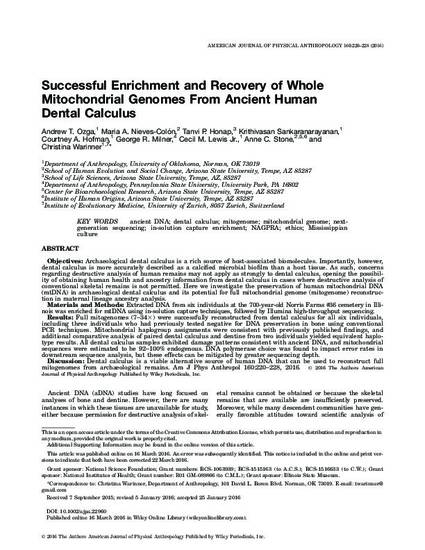
- Ancient DNA,
- Dental calculus,
- Mitogenome,
- Mitochondrial Genome,
- Next-Generation Sequencing,
- In-Solution Capture Enrichment,
- NAGPRA,
- Ethics,
- Mississippian culture
Objectives
Archaeological dental calculus is a rich source of host‐associated biomolecules. Importantly, however, dental calculus is more accurately described as a calcified microbial biofilm than a host tissue. As such, concerns regarding destructive analysis of human remains may not apply as strongly to dental calculus, opening the possibility of obtaining human health and ancestry information from dental calculus in cases where destructive analysis of conventional skeletal remains is not permitted. Here we investigate the preservation of human mitochondrial DNA (mtDNA) in archaeological dental calculus and its potential for full mitochondrial genome (mitogenome) reconstruction in maternal lineage ancestry analysis. Materials and Methods
Extracted DNA from six individuals at the 700‐year‐old Norris Farms #36 cemetery in Illinois was enriched for mtDNA using in‐solution capture techniques, followed by Illumina high‐throughput sequencing. Results
Full mitogenomes (7–34×) were successfully reconstructed from dental calculus for all six individuals, including three individuals who had previously tested negative for DNA preservation in bone using conventional PCR techniques. Mitochondrial haplogroup assignments were consistent with previously published findings, and additional comparative analysis of paired dental calculus and dentine from two individuals yielded equivalent haplotype results. All dental calculus samples exhibited damage patterns consistent with ancient DNA, and mitochondrial sequences were estimated to be 92–100% endogenous. DNA polymerase choice was found to impact error rates in downstream sequence analysis, but these effects can be mitigated by greater sequencing depth. Discussion
Dental calculus is a viable alternative source of human DNA that can be used to reconstruct full mitogenomes from archaeological remains. Am J Phys Anthropol 160:220–228, 2016. © 2016 The Authors American Journal of Physical Anthropology Published by Wiley Periodicals, Inc.
Available at: http://works.bepress.com/andrew-ozga/17/

© 2016 The Authors American Journal of Physical Anthropology Published by Wiley Periodicals, Inc.
This is an open access article under the terms of the Creative Commons Attribution License, which permits use, distribution and reproduction in any medium, provided the original work is properly cited.